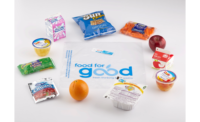Mondelēz International launched its sustainable cocoa sourcing program, Cocoa Life, in 2012. Since then, the company says it has observed some significant impacts of weather changes across the regions that produce much of its cocoa.
Cocoa farming has been found to be a significant source of carbon emissions. Mondelēz conducted an environmental impact assessment in 2016 and learned that the biggest driver of its end-to-end carbon footprint is the deforestation within its supply chain.
Now, Mondelēz has announced it is collaborating with governments in both Côte d’Ivoire and Ghana to reduce deforestation in the cocoa supply chain. Côte d’Ivoire and Ghana produce 60 percent of the world’s cocoa supply, and deforestation rates in each region are estimated, according to the United Nations, at 2.7 and 2.9 percent, respectively. Moreover, most of the deforestation is happening as a result of the expansion of cocoa farming.
In the following Q&A, Cathy Pieters, program director for Cocoa Life, provides additional details of Mondelēz International’s cocoa sustainability efforts.
FE: Why was it important for Mondelēz International to start a sustainable cocoa sourcing program? What was the impetus?
Pieters: As one of the world’s largest chocolate companies and one of the largest buyers of cocoa worldwide, we know a sustainable cocoa supply is vital for the future of chocolate. We have a saying: Without cocoa, there is no chocolate. And without the next cocoa farming generation, there is no cocoa.
Cocoa Life is our long-term journey to create a vibrant, strong cocoa supply chain while transforming the lives and livelihoods of farmers and their communities. The ultimate goal is to source all of the company’s cocoa sustainably. Through Cocoa Life, we're working to empower 200,000 farmers and reach one million community members across six cocoa origins by 2022.
FE: Will this effort also help its transparency of the company’s ingredients in the supply chain? Also, will it help to ensure the company’s cocoa will be available? If yes, how so?
Pieters: Cocoa Life is independently verified. We work with FLOCERT, a leading global certification body, to verify the flow of cocoa from Cocoa Life communities into the supply chain and the benefits received by farmers.
In this way, Cocoa Life connects the beginning and end of the cocoa supply chain, so farmers can see how their crop contributes to the chocolate that people enjoy. Consumers can also better understand the origins of their chocolate.
One of our objectives is to ensure a long-term supply of sustainable, high-quality cocoa. This begins with empowered farmers in thriving communities. To achieve this, Cocoa Life promotes better farming practices to improve productivity and protect fertile land for future generations, entrepreneurship to raise income from cocoa and other sources, and more.
FE: Will this be communicated to consumers? If yes, how?
Pieters: The Cocoa Life logo will be labeled on our products as volumes grow, indicating that the cocoa beans have been sustainably sourced from Cocoa Life communities. Various regional and global brands such as Cadbury already show this logo on their products. We believe seeing Cocoa Life on packaging will prompt consumers to learn more about the program at www.cocoalife.org.
FE: How will this collaboration help the African communities involved?
Pieters: Deforestation is a driver of climate change. Cocoa farmers and community leaders in West Africa say climate change is already impacting their farms. That’s why we're working with the governments in Côte d’Ivoire and Ghana, two of the leading cocoa-producing countries, to step up efforts to protect forests and help farmers become more resilient against the effects of climate change. These two countries alone account for close to 60 percent of the world’s cocoa supply.
These partnerships will enable us to better assess and address the needs of cocoa farming communities:
• In Côte d’Ivoire, the company signed a Memorandum of Understanding with the Ministry of Environment as part of the country’s REDD+ program to support its goal to reach zero deforestation in cocoa. Together, they will engage local communities to produce a forest protection map and implement a tracking system to identify risks and opportunities to restore forest cover. The partnership will also promote good agricultural practices that enable farmers to improve productivity, adopt agro-forestry systems and free up land for reforestation.
• In Ghana, the company will partner with the Forestry Commission and the UN Development Programme to establish a REDD+ partnership in the country.
FE: Anything else you would like to comment on?
Pieters: We're building on our efforts and will continue to prioritize climate change resilience, along with women’s empowerment and child protection, across our five focus areas: farming, community, livelihoods, youth and environment.




